For tourists visiting India, autorickshaws are an indispensable mode of transport. These vibrant, three-wheeled vehicles offer an authentic, budget-friendly way to navigate the chaotic streets of Indian cities. Whether you’re exploring bustling markets in Delhi or serene lakesides in Udaipur, autorickshaws are perfect for short trips. With their local charm, autorickshaws offer a unique peek into India’s culture and vibrant street life.
However, for many international tourists, riding in an autorickshaw can be a bit daunting if you’re not prepared. Here’s everything you need to know for a smooth and enjoyable experience.
Understanding the Autorickshaw
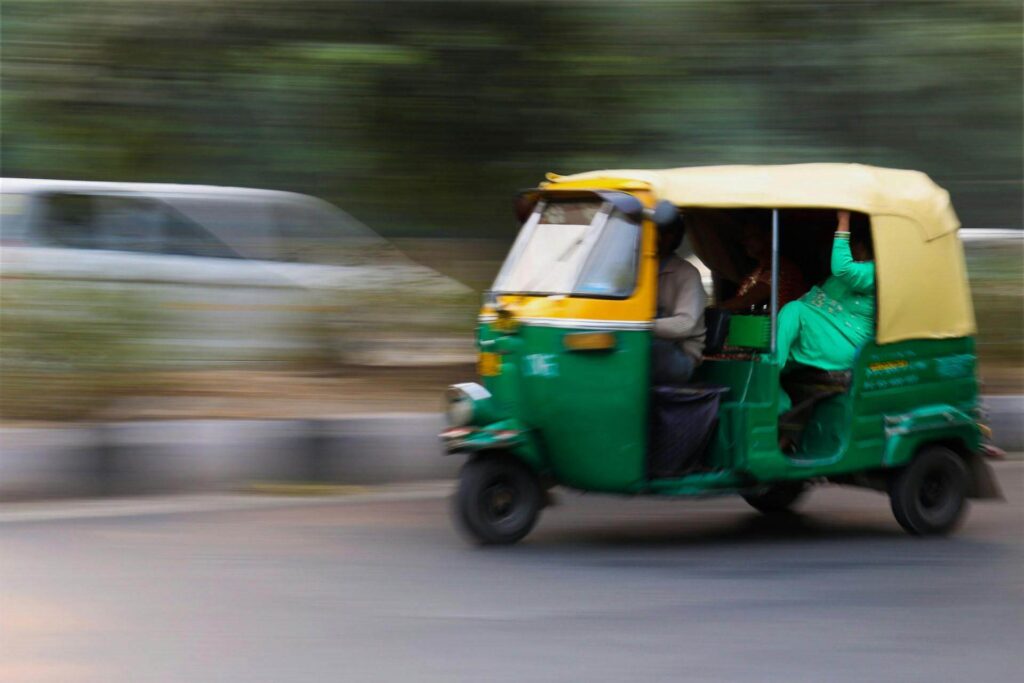
Autorickshaws are compact, three-wheeled vehicles built for short-distance travel. They’re the go-to choice for weaving through narrow streets, congested traffic, or reaching places where larger public transport can’t fit. The ride can be a thrilling adventure, but a little know-how goes a long way in making it a comfortable one.
In India, autorickshaws have different names depending on the city—and contrary to what you might read online, “Tuk-Tuk” isn’t one of them! While that term might be popular in Thailand, it’s not used for rickshaws in India. In Delhi, Chennai, and parts of the north and south, they’re simply called “Auto.” Meanwhile, in Mumbai and Bangalore, they go by “Rickshaw.” So, when you hop in, don’t expect to hear “Tuk-Tuk” – you’re in for a proper Indian ride!
Introduction of Autorickshaw in India
The autorickshaw emerged as a solution to the growing congestion in Indian cities during the 1950s.
In 1959, Bajaj Auto (then known as Bachraj Trading Corporation) partnered with Italy’s Piaggio to manufacture the first autorickshaws in India. The vehicle dubbed the “Bajaj Auto Rickshaw,” was modeled after the Vespa three-wheeled vehicle, which was already popular in Europe.
The first Bajaj autorickshaws were initially manufactured in Mumbai, and they quickly gained popularity in Indian cities as a solution to the growing congestion and lack of adequate public transport options.
Initially, the Indian government had a limited role in directly promoting autorickshaws, but over time, as the demand grew, the government introduced regulatory measures to streamline their operation. In the 1970s, the Indian government, recognizing their importance in urban transport, formalized their role by introducing specific licenses and permits for autorickshaw operators. The government also set up specific guidelines for vehicle emissions and safety standards, gradually evolving towards creating a more sustainable and efficient urban transport network.
In recent decades, the government has encouraged eco-friendly versions of the autorickshaw. The introduction of electric rickshaws (e-rickshaws) was supported by the Indian government as part of the push towards reducing pollution in urban areas. Additionally, subsidies and tax incentives were provided to promote the use of electric vehicles, ensuring that autorickshaws continue to serve as an essential part of India’s transport landscape.
Technical Aspects of Indian Autorickshaws: Why They Can Be a Challenging Ride for Passengers
While they provide a convenient and affordable mode of travel, passengers often find the ride uncomfortable due to various technical factors inherent to the design and maintenance of these vehicles. Here are the key technical aspects that can make the ride less than smooth.
Suspension System
One of the primary factors contributing to an uncomfortable ride in an autorickshaw is its suspension system—or the lack thereof. Most autorickshaws use basic suspension systems that fail to absorb bumps and potholes on India’s often uneven roads. The hard suspension results in a jarring experience, particularly when driving over speed bumps or rough patches of tarmac. Passengers often feel every bump and pothole, which can make even short trips feel much longer and more uncomfortable.
Engine Power and Performance
Autorickshaws in India are typically powered by small, low-powered engines, most of which are two-stroke engines running on petrol, or in some cases, compressed natural gas (CNG). While these engines are economical, they lack the smooth performance of larger, more refined engines. This often results in erratic acceleration, jerky starts, and uneven power delivery. Passengers may feel the sudden shifts in speed, making the ride feel less stable and more unpredictable.
Weight and Balance
Autorickshaws are light vehicles, but their three-wheeled design and small wheel size can make them less stable, especially when carrying passengers at full capacity. When the weight distribution isn’t balanced correctly, or when the vehicle is overloaded, it can become prone to tipping, which adds to the overall instability. Although tipping is rare, passengers may feel uneasy during sharp turns or when driving on unsteady roads.
Condition of Autorickshaws
Autorickshaws are basically poor man’s cabs. So their maintenance is also accordingly.
Many autorickshaws in India are older models that have seen years of wear and tear. Regular maintenance can often be inadequate, leading to problems with engine performance, brakes, and other critical systems. Passengers may experience stalling, strange noises, or difficulty in starting and stopping the rickshaw. The lack of modern safety features, such as airbags or proper seat belts, adds to the risk and discomfort.
Air Conditioning (or Lack of it)
Another technical issue that makes the ride uncomfortable, especially in hot climates, is the absence of air conditioning. In cities with heavy traffic, this can lead to a very unpleasant experience, with exhaust fumes, dust, and the stifling heat becoming unbearable.
Noise Pollution
The noise levels inside an autorickshaw can be another source of discomfort. The combination of the engine’s loud noise, the vibrations from the road, and the chaotic traffic around the vehicle creates an environment that is both noisy and stressful. This can be particularly challenging for passengers who are not used to such high levels of ambient sound, making the ride mentally tiring, in addition to physically uncomfortable.
Braking and Steering Issues
Braking and steering in many Indian autorickshaws can also be less than ideal. Due to the small size of the vehicle and the strain placed on its parts over time, the braking system can sometimes feel unresponsive, leading to sudden, hard stops. Similarly, the steering can be difficult to handle, especially on winding or uneven roads, which increases the risk of jerky turns and unexpected movements.
Autorickshaws of Different Cities, Different Character
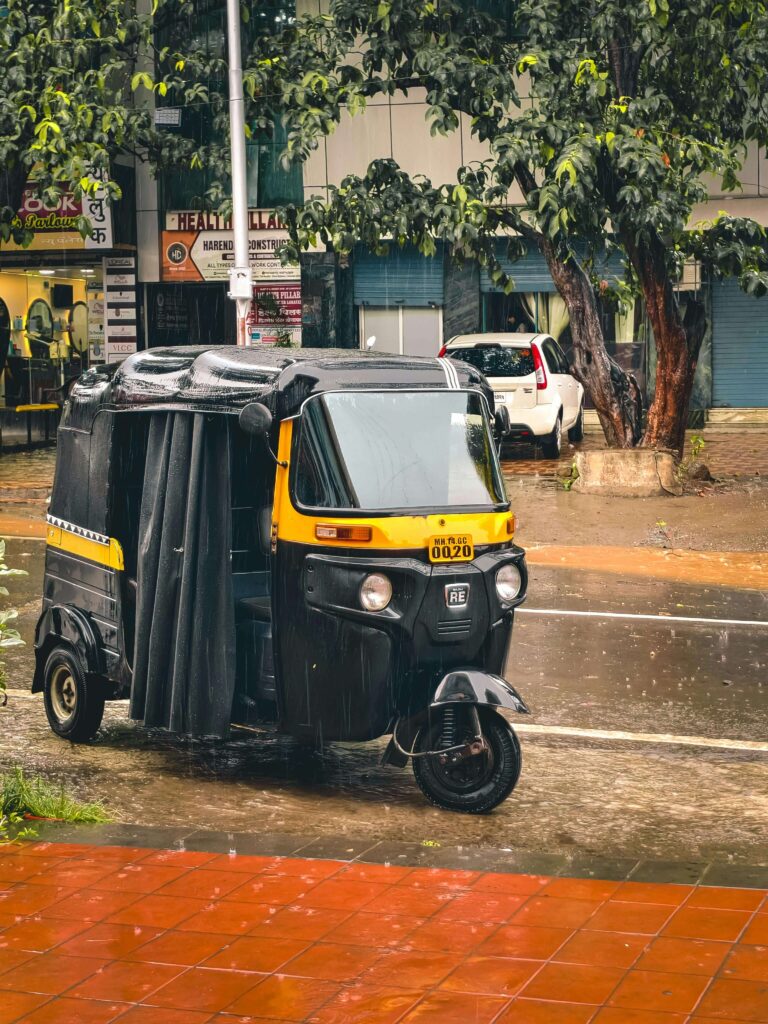
While Autorickshaws are available in most Indian towns, let’s dive into the key differences between those of Delhi and Mumbai. These two cities decide the traits of autorickshaw drivers in most western and northern towns.
Driver Behavior and Professionalism
In Delhi, the behavior of autorickshaw drivers can sometimes be a point of contention. Passengers often report that drivers in the capital city are more inclined to refuse short trips or demand higher fares, especially if they perceive the passenger as unfamiliar with the area. Drivers are notorious for not using meters and bargaining for a fare instead.
On the other hand, Mumbai’s rickshaw drivers are generally seen as more professional and courteous. The drivers in Mumbai are known for their honesty and willingness to go by the meter, making the experience more predictable for passengers. They often maintain cleaner vehicles and offer a more pleasant ride.
Vehicle Conditions and Comfort of Autorickshaws in Different Cities
Another noticeable difference lies in the condition and comfort of the rickshaws themselves. In Delhi, some autorickshaws, particularly those on older routes, might not be as well-maintained. The ride can be bumpier, with older models making the experience less comfortable for passengers. The interiors of these rickshaws might not be as clean either, and you may sometimes find the driver smoking or eating inside the vehicle.
In contrast, the rickshaws in Mumbai tend to be more regularly serviced and in better condition. The city has a more standardized approach to vehicle inspections and maintenance. The ride in a Mumbai rickshaw is generally smoother, and the interiors are usually more hygienic, providing a more pleasant travel experience.
A City’s Cultural Vibe Through its Autorickshaws
Delhi’s autorickshaws reflect the city’s larger-than-life character. The rickshaws are often crowded and chaotic, much like the city itself. The drivers are familiar with the traffic jams and hustle-bustle of Delhi and are known for their competitive driving style, which can make the ride thrilling, though at times stressful. Some Delhi drivers may also share anecdotes and news, adding a local flavour to the ride.
Mumbai, being more fast-paced and commercial, has a different vibe. The city’s rickshaw drivers are more accustomed to dealing with tourists, professionals, and business people. There’s an air of efficiency, and most drivers focus on getting you from point A to B most quickly and straightforwardly. While they are equally knowledgeable about the city, the interaction feels less chaotic and more straightforward compared to Delhi’s rickshaw rides.
Fare Systems in Different Cities
Fares in Delhi can often be a gray area. Many rickshaw drivers prefer negotiating a price over the meter, especially for short trips or if the passenger seems unfamiliar with the area. This can make the ride feel like a gamble, as passengers may end up paying more than expected.
In Mumbai, on the other hand, the fare system is relatively more transparent. Most rickshaws in Mumbai have meters, and drivers typically follow the metered fare. This predictability and standardization make it a more reliable experience for passengers, locals or tourists alike.
How to take an autorickshaw
In India, autorickshaws offer two main types of rides: private and shared. Understanding the difference will help you choose the right option based on your preferences and needs.
Private Rides: These are the most common form of rickshaw rides where you hire the vehicle exclusively for yourself.
Shared Rides: In contrast, shared rides involve multiple passengers who follow similar routes. Such autorickshaws usually ply between popular or busy locations, like stations and office areas. There are a few versions of shared autorickshaws depending on the city you are in and can accommodate more than 2-3 passengers. However, this is not the rule. You might find a regular-sized autorickshaw telling you operating on a shared route. This option is more economical, as the fare is split among passengers. But it might take longer to reach your destination since the driver often waits to fill the vehicle before departing.
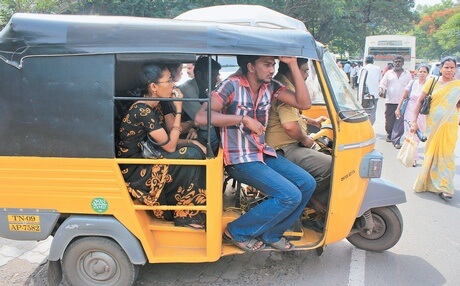
How to Hail an Autorickshaw

Hailing an autorickshaw is fairly straightforward, though it can vary by city. In most places, you can simply flag down a rickshaw on the street by raising your hand.
In major cities like Mumbai, autorickshaws are generally easy to spot and can be hailed directly from the roadside.
Autorickshaws are not permitted in South Mumbai (South of Bandra).
You can also apps like Ola & Uber to book one and even set the fare meter in advance, helping eliminate the need for bargaining or any price confusion.
Apart from hailing on the street, you can also look for autorickshaw stands near busy hubs like railway stations, markets, or tourist attractions. You’ll also find them near key public transport stations, where they act as a convenient option for short-distance travel.
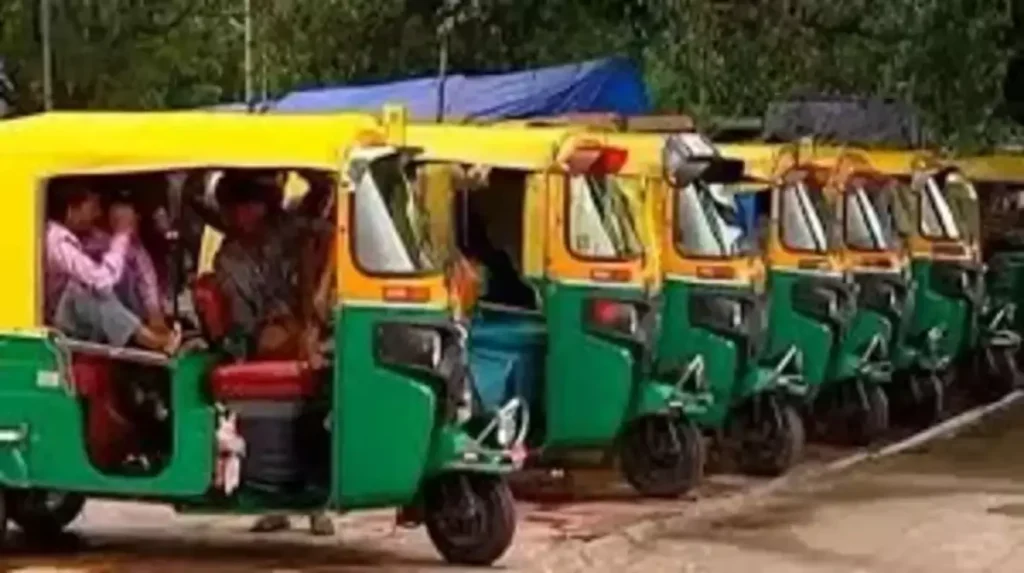
Bargaining Tips
When negotiating, it’s helpful to start with a lower price and slowly work your way up, as many drivers expect a little back-and-forth. If you’re unsure of what a fair price should be, do a quick online search or ask a local for guidance. Be respectful during the negotiation, and always keep some cash handy for tipping at the end of your ride. There is no tipping culture in India. But if you don’t give exact cash, be aware that many drivers wouldn’t return the change (it doesn’t happen in Mumbai though).
Safety and Comfort Considerations
While autorickshaws are generally safe, traffic in Indian cities can be chaotic. It’s advisable to check the condition of the vehicle before hopping in – look for any loose parts or signs of wear that might affect the safety of the ride. Moreover, avoid riding in the rickshaw at night if you’re not familiar with the area, especially in less populated or poorly lit places.
Be Prepared for the Ride
Autorickshaw rides are always bumpy and noisy. Be ready for the hustle and bustle, as traffic jams and the constant honking of horns are part of the charm. It’s common for rickshaws to take unconventional routes to avoid congestion. Communicate your needs clearly with the driver if you want to stick to the standard routes on the maps. Also, try to have an idea of your destination’s location to avoid confusion.
Electric Auto Rickshaws (E-Rickshaws)
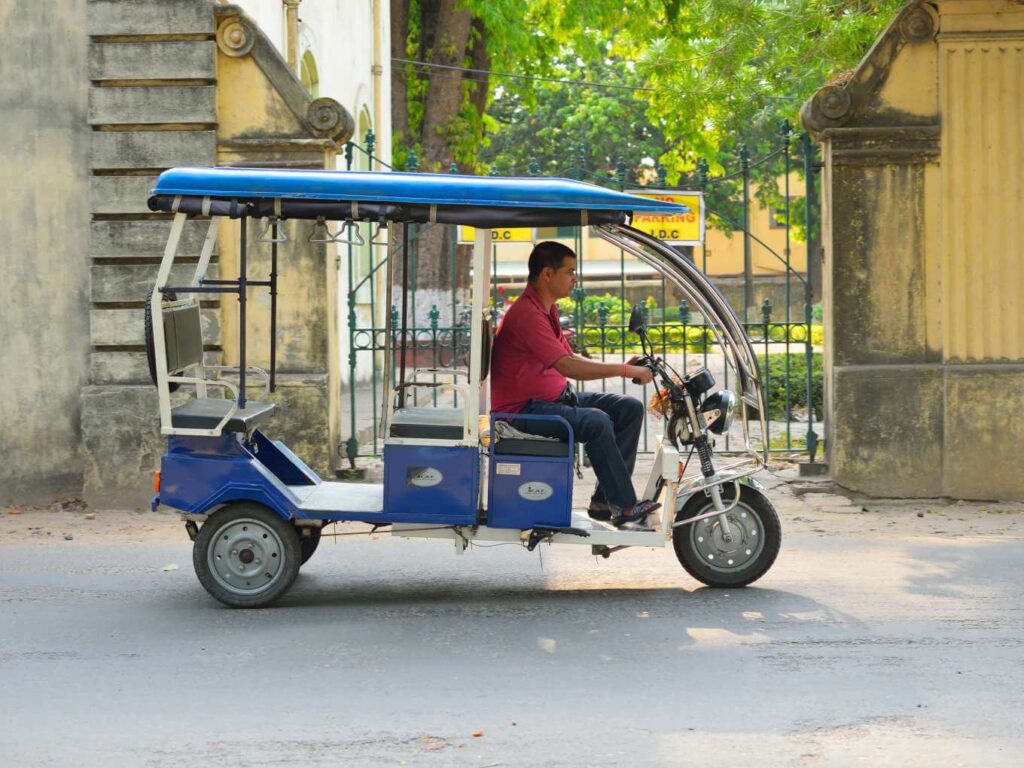
As part of India’s initiative to reduce pollution, electric autorickshaws (e-rickshaws) have become increasingly popular in certain cities. These eco-friendly alternatives, running entirely on batteries rather than fossil fuels, offer a quieter and more sustainable way to travel short distances, especially in areas with high levels of air pollution. E-rickshaws are often a bit more comfortable and can be a refreshing alternative to the traditional ones.
Differences Between Autorickshaws and E-Rickshaws from a Tourist’s Perspective:
- Fuel Source:
- Autorickshaw: Runs on petrol or diesel, producing emissions and contributing to air pollution.
- E-Rickshaw: Powered by electricity, significantly reducing emissions and making them quieter and more eco-friendly.
- Environmental Impact:
- Autorickshaw: Due to its reliance on fossil fuels, it has a higher environmental impact, especially in busy urban areas.
- E-Rickshaw: No tailpipe emissions, which helps reduce both air and noise pollution, making it a cleaner and greener choice.
- Cost:
- Autorickshaw: Typically, autorickshaws are slightly more expensive due to their higher fuel costs and maintenance.
- E-Rickshaw: With lower operating costs (electricity is cheaper than petrol or diesel), E-rickshaws often offer a more affordable ride for short distances.
- Ride Experience:
- Autorickshaw: Offers a faster ride, especially suited for longer distances, but the ride can sometimes be bumpy and noisy due to the engine.
- E-Rickshaw: The ride is typically smoother and quieter, with less vibration, making it a comfortable choice for short trips around busy areas.
- Speed:
- Autorickshaw: Autorickshaws are generally faster and can reach speeds up to 60 km/h, making them suitable for longer journeys within cities.
- E-Rickshaw: E-rickshaws are slower (usually around 25-30 km/h), which makes them ideal for shorter distances like market runs or trips around local neighborhoods.
- Capacity:
- Autorickshaw: Usually accommodates 2-3 passengers.
- E-Rickshaw: Typically designed for 3-4 passengers, making them a better option for small groups but solo tourists can also hire them for a comfortable experience.
- Noise Levels:
- Autorickshaw: Can be noisy due to the engine running on fuel, especially in dense traffic.
- E-Rickshaw: Much quieter, as it runs on electric power, making it a peaceful mode of transport, especially in the noisy streets of India [1].
- Accessibility:
- Autorickshaw: Available widely across Indian cities.
- E-Rickshaw: They are still gaining popularity and might not be available as widely as the regular ones.
Which Type of Rickshaw is Better for a Tourist?
- E-Rickshaw is ideal for tourists looking for a cleaner, quieter, and more affordable option. The environmental benefits make it the perfect choice for eco-conscious travelers.
- Autorickshaw is best for tourists for a quick and hassle-free commute because they are easily available.
Where to Find The Autorickshaws?
- Autorickshaws: Easily spotted in all major cities, often stationed at busy intersections, markets, or transport hubs like train stations or airports.
- E-Rickshaws: Common in areas with heavy foot traffic and in tourist spots. You’ll find them near local markets, temples, and tourist attractions.
If you land at the Mumbai airport, don’t take a rickshaw if you have to head to South Mumbai. Since they are not permitted there, the drivers will drop you at the limit from where you have to take a cab. Better book a cab at the airport itself.
Autorickshaws are a unique part of the Indian public transport system. With all their strengths and and weaknessess, they are exotic items that one should try at least once when traveling to India.

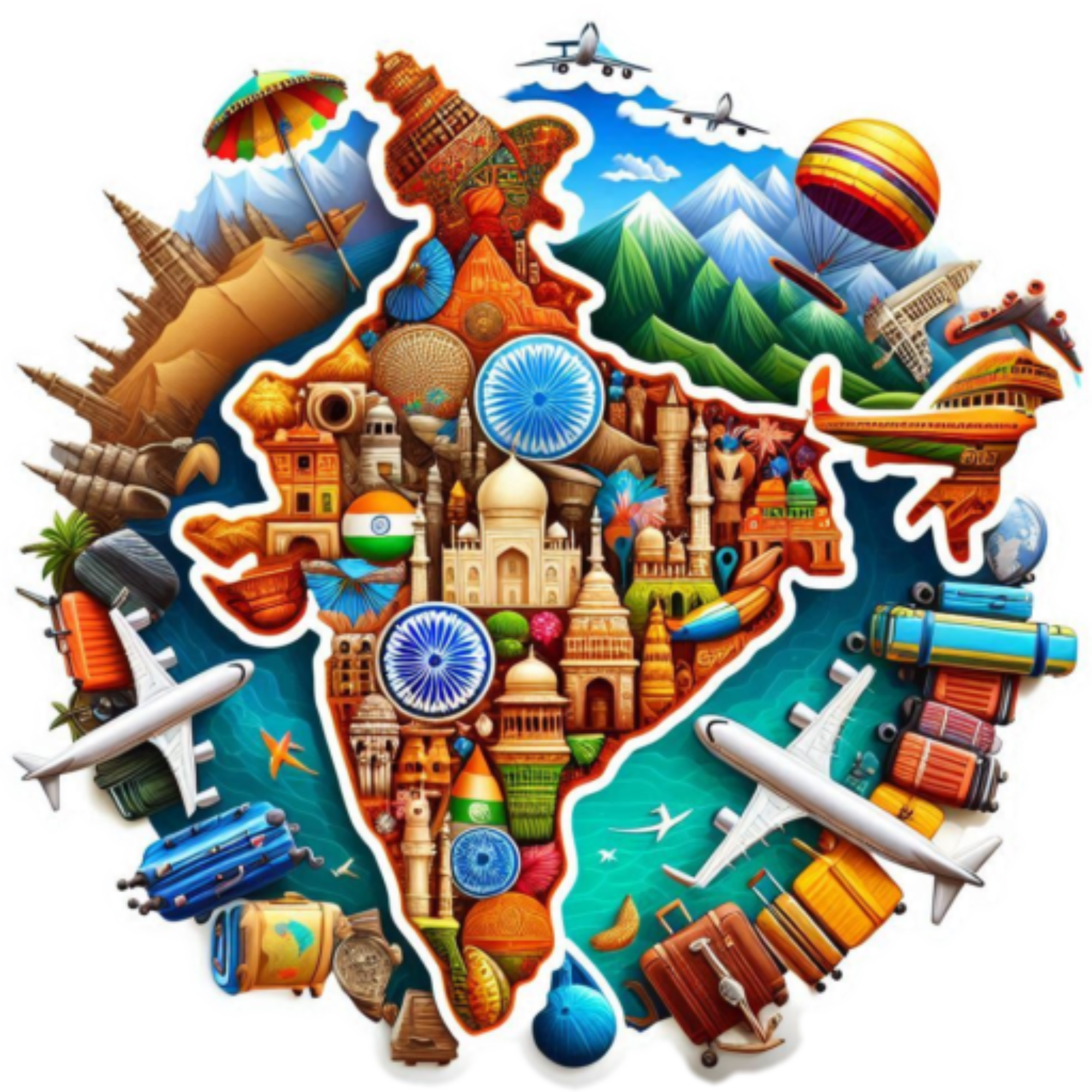



Pingback: Backpacking to India: Here's how to plan it well - Traveling to India?
Pingback: Everything You Need to Know about Sanjay Gandhi National Park: A Complete Guide for the Tourists - Traveling to India?
Pingback: Everything You Need to Know about Mumbai Weather: A Complete Guide for the Tourists - Traveling to India?